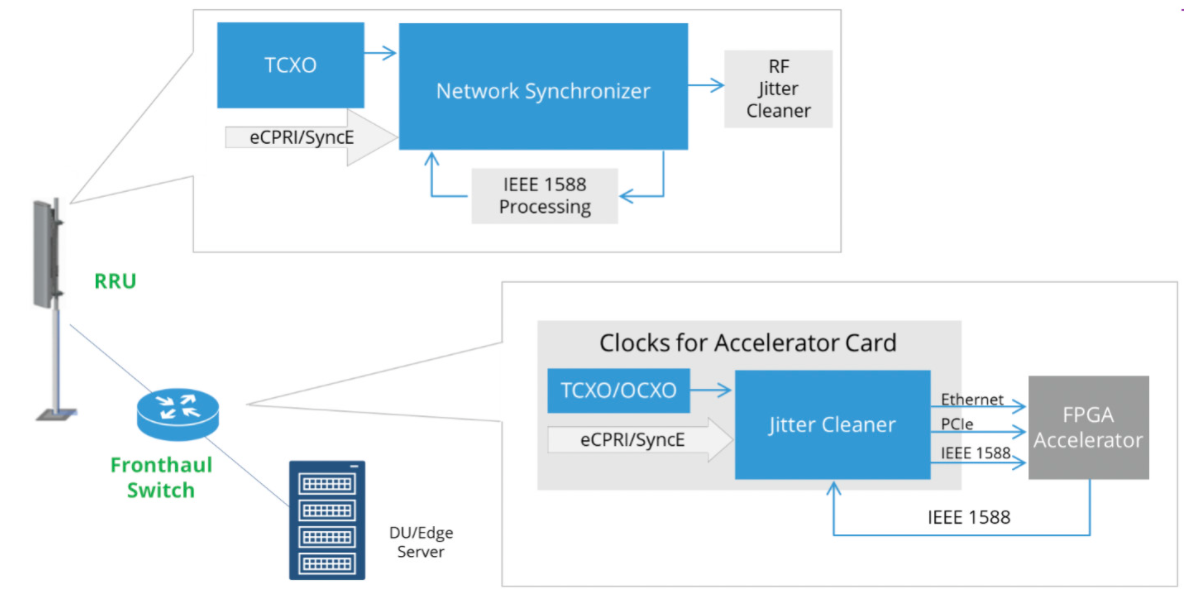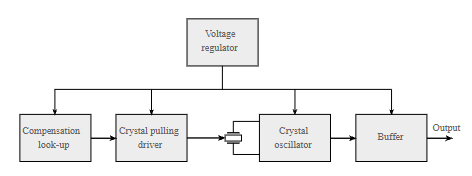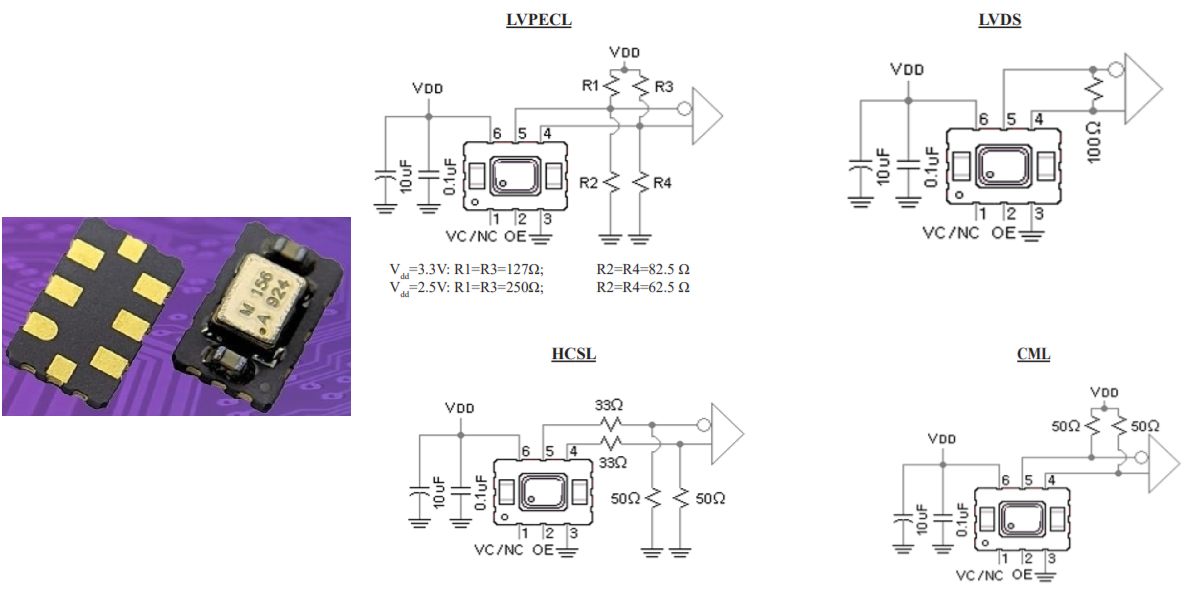Take the Poll | Join our Discussion
sponsored by

Synchronizing the 5G Network
The 5G (5th Generation) mobile network connects machines and devices at higher data speeds, and with ultra-low latency when compared with its predecessor, 4G. In order to maintain consistent operation and high reliability, network components must be synchronized. Accurate timing (clocking) plays a crucial role in maintaining synchronization within a mobile network. Inaccuracies in synchronization and timing can lead to interference between nodes in a radio access network (RAN). Error-prone oscillators and clocks can cause time shifts that result in deterioration of performance and reliability. This article explores the importance of clocking in network synchronization and the challenges which arise when using oscillators in a 5G network.
What is an Oscillator?
An oscillator is an electronic circuit that uses a crystal to generate a periodic electrical signal with constant frequency, also known as a clock or timing signal. Most digital circuits rely on clock signals in order to synchronize the different components within them. The following section describes how crystal oscillators are used in 5G application devices for network synchronization.
|
How does a crystal generate a clock signal? |
Clocking and Synchronization in 5G Applications
The goal of a radio access networks (RAN) is to optimize service performance and reliability. A RAN is comprised of different commponents that are synchronized, each contributing functionality in order to deliver required services. Timing accuracy and availability are important considerations for the end product, as well as cost.
Figure 1 shows an open RAN architecture. It consists of a remote radio unit (RRU), fronthaul switch, and a distributed unit (DU). The block diagram shows a crystal oscillator (TCXO and OCXO) generating the clock signal to synchronize these devices. The remote radio unit (RRU) serves as the consumer's access point to the network. The distributed unit (DU) connects the central unit (CU) and the mobile core. The fronthaul switch routes traffic between the RRU and DU. These components need to be precisely synchronized to avoid data packet loss and system interruptions.

Figure 1: Block diagrams of the role of an oscillator in the RRU and DU systems
Image Source: Embedded Computing Design
Many 5G networks rely on Time Division Duplexing (TDD), a method of duplex communications where inbound signals are separated from outbound signals based on time allocation in the same frequency band. This requires all devices to be precisely synchronized. This synchronization is typically based on the IEEE 1588 Precision Timing Protocol (PTP). Synchronous Ethernet (SyncE) is another standard that can be used synchronizing frequency. The network architecture dictates whether PTP, SyncE, or both are used for synchronization.
In PTP, a device called the grandmaster uses a sync source (usually GPS-based) to create several timestamped PTP packets that are delivered to follower clocks at other locations. The packets are used to calculate the time offset between the grandmaster and follower clock, after which a local clock signal can be generated by the follower clock at its own location. PTP is an intelligent system, and is able to adapt to grandmaster loss.
SyncE is an older system in which a high quality clock reference (usually from a GPS or Cesium clock source) is used to time the output from the core of the network. At other locations on the network, clock recovery takes place, analyzing the signal edges of the output signal and using them to derive their own clock signal for the receiving equipment.
The DU must pass a precisely synchronized timing signal to the fronthaul switch and the RRU. Clocking in the DU should be resistant to issues such as heat under a heavy load, or the addition of a fan to the system. The RRU needs to be the most environmentally robust, because they are usually placed outdoors, on rooftops and poles, and near roads and highways. Because precise synchronization needs to be maintained between the DU, fronthaul switch, and RRU, jitter cleaners are used to reduce any jitter that might occur due to environmental factors.
Challenges with Oscillators in 5G Applications
Environmental stress can have an effect on oscillator performance. An oscillator's frequency slope describes how the frequency behaves when ambient temperatures vary. High-frequency slopes correspond to sudden frequency changes. Figure 2 compares the frequency over temperature slope of the MEMS-based TCXO and three quartz-based TCXOs. In PTP-dependent applications, a low frequency over temperature slope allows the oscillator to maintain an accurate reference between timing packets, even under a fast temperature ramp.
5G networks rely on a large density of radios, and as such, radios are often mounted in locations that are subject to vibration from multiple sources, including trucks, trains, cars, wind, and thunder. Oscillators deployed in these radios must maintain stable performance during environmental stress to prevent dropped links.

Figure 2: Frequency over Temperature Comparison of the MEMS TCXO and three quartz-based TCXOs
Image Source: Embedded Computing Design
Types of Clocks (Oscillators)
Oscillators are categorized into various types, depending on their working function and structure, including LC resonators, ceramic resonators, crystal oscillators, and the atomic frequency standards like Cesium and Rubidium-based oscillators.
Crystal Oscillators
Crystal oscillators are quartz crystal-based and have self-compensated temperature stability, superior initial accuracy, and are available at moderate cost. They offer excellent stability and can serve a stable clock source for many contemporary connectivity protocols, such as Wi-Fi, Bluetooth, and Zigbee, as well as Ethernet, LIN/CAN, and industrial applications. Crystal oscillators also come in different varieties:
- Quartz oscillators (XO) integrate an oscillator die with a quartz crystal. These offer quartz-like accuracy and low noise benefits, but suffer from board trace-induced decreasing variability. It is necessary to use an XO instead of a bare quartz crystal in minimal noise systems. Quartz oscillators deliver the low noise at high frequency operation.
- Oven-controlled crystal oscillators (OCXOs) use a thermostatically controlled oven to maintain a higher-than-room temperature, and thus deliver a stable signal source at a constant temperature. OCXO's can achieve a high precision of +/-0.1ppm to 0.1ppb or better.
- Micro-electro Mechanical Systems (MEMS) have evolved in parallel to quartz. Miniature silicon-based MEMS oscillators are resistant to shock and vibration. The complexity of MEMS resonators, however, makes them expensive. The durability and size of MEMS oscillators enable them to work well in wearables, wireless charging pads, industrial controls, and other applications.
- Temperature-compensated quartz crystal oscillators (TCXOs) are crystal oscillators with a temperature-sensitive reactance circuit in their oscillation loop, which is used to compensate for the frequency-temperature characteristics inherent to the crystal unit. Figure 3 shows a block diagram of a TCXO unit. A Voltage Controlled Crystal Oscillator (VCXO) is an important TCXO component that links to a temperature sensing circuit and applies minute correction voltages to the oscillator. TCXOs provide stabilities of 1 part per million (ppm) to 0.1 ppm. A notable advantage of a TCXO is its relatively high stability while consuming minimum power (several milliwatts). These can thus be ideal for multiple communications and telecom applications, such as point-to-point RF, GNSS/GPS, mobile phones, and other precision RF connectivity systems.

Figure 3: A TCXO Block Diagram
Image Source: Electronics Notes
Atomic Frequency Standard Oscillators
Certain atoms emit and absorb electromagnetic radiation (EM) at resonance frequencies that can be used to derive a stable timing signal. Common atoms used in atomic clocks are Cesium, Rubidium, and Hydrogen, which have resonance frequencies of 9.2 GHz, 6.8 GHz, and 1.4 GHz, respectively. Because the properties of isolated atoms in free space and at rest do not change with space and time, atomic clocks are stable over time and less affected by changes in the environment.
Abracon TCXO Clocks
The Abracon ASGTX5 TCXO series are factory-programmable oscillators that are jitter and stability optimized. They provide stable, high-frequency clocking at a small footprint of 5.0mm x 3.2mm, necessary characteristics for driving a communications infrastructure. Designed for +/-3ppm over a broad -40 °C to 85 °C temperature range, these devices meet the Stratum 4 clocking requirements used in edge networking equipment. They are also capable of improving phase-locked loop (PLL) lock time and performance in broadcast and professional video applications.
Abracon’s TXCO oscillators are factory configurable to output frequencies from 15MHz to 2.1GHz, and support LVPECL, LVDS, HCSL, or CML output logic types with voltage options to 1.8V. Figure 4 shows recommended testing circuits for different output logic types. The enabled output can be configured for any combination of pin 1 or pin 2 and active high or active low functionality. The ASGTX5's design flexibility is important in applications that require backward compatibility with specific pinout or firmware combinations. ASGTX5DAF1-250.0000, ASGTX5PAF1-156.2500T2, and ASGTX5DAF1-125.0000 are some examples from this series.

Figure 4: Abracon ASGTX5 TCXO series Oscillator and Recommended Test Circuit for LVPECL, LVDS, HCSL, and CML logic Output
Image Source: Abracon
Summing up: Network Synchronization
Effective network synchronization is vital for stable and reliable network performance. Various compelling use cases for 5G, such as IoT and Industrial Automation, require precise timing, and the need for accurate synchronization will continue to grow in the near future. The ASGTX5 TCXO series oscillators from Abracon provide stable clocks at high frequencies in a small footprint, making them well-suited candidates to handle clocking duties for 5G applications.
